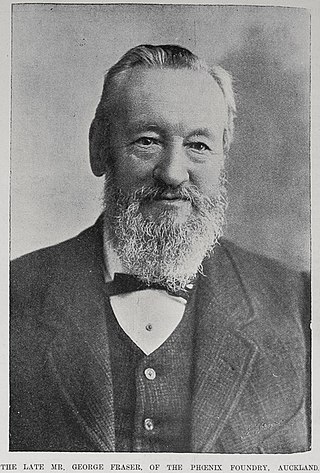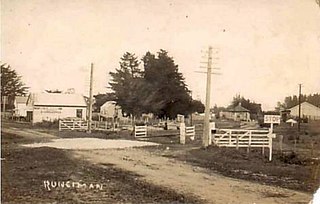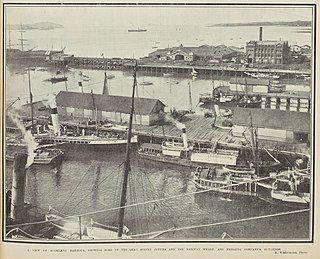Novelty was a barque-rigged iron paddle steamer, built at Sydney in 1863.
Novelty was a barque-rigged iron paddle steamer, built at Sydney in 1863.
Novelty was launched in 1863 by P.N. Russell and Company, the Sydney foundry owned and operated by the Australian engineer Peter Nicol Russell. Its length was 82.5 ft, beam 15.5 ft, depth 5.3 ft, weight 376 tons. [1] After being delivered to New Zealand, Novelty was outfitted and furnished in Auckland, where there was a launching ceremony on 1 February 1863. The New Zealander newspaper described Novelty in its report of the launching ceremony:
From truck to deck, all is clean, well set up, and ship shape' her masts well placed and stayed; and her rigging sweated down until her shrouds stand out like so many bars of iron;-in fact, the greater proportion of her stays are so, being of iron wire rope. She is fitted with double topsail yards...
She has a top-gallant forecastle, and raised quarter-deck; with an officer's house and cabin staircase...
The saloon is a very chaste apartment, of great length and height with remo styles and mouldings, with open iron scroll work for ventilation. which gives a graceful and airy appearance. The births are roomy and well planned. [sic] [2]
Novelty was owned by a Mr T Henderson, [3] its agents were Henderson & Macfarlane, Auckland, and its master from the time of launching was a Captain Austin.
From the date of launching, the vessel made numerous international voyages from New Zealand, carrying passengers [4] and cargo. [5] Most voyages recorded are between New Zealand and Australia, though the vessel also sailed to San Francisco and Tahiti, with passengers and cargo. [6] Novelty was also used as a military troop transport. [7]
In early 1864, while entering Auckland harbour returning from a voyage, Novelty ran aground on rocks outside the North Head. The vessel was removed from the rocks and thought to be undamaged, though it had in fact lost a piece of its false keel. [8] On its next voyage between Auckland and Sydney in July 1864, Novelty began to leak. The crew pumped, though became exhausted. The Captain, Captain Austin, reportedly ordered the boats be destroyed to prevent the crew from leaving the vessel, saying "now if the ship goes down we will all go down with it". The crew returned to pumping, and Novelty arrived safely in Sydney. [9] One of the sailors on board, David Bartlett, subsequently wrote to The New Zealand Herald newspaper, claiming that the account published was "a concocted tissue of falsehoods", and that the crew "did their duty as becomes the character of British seamen (pump or sink)"[sic]. Bartlett also noted that the boats were visible, undamaged, on Novelty's deck, proving the published account was false. [10] The Taranaki Herald , reporting on the same incident, stated that Captain Austin had only threatened to destroy the boats, if the crew stopped pumping. [8]
Novelty ran aground again off Sumner in August 1866, though was recovered. [11]
Novelty was wrecked off Quail Island, Lyttelton Harbour, in 1887. [1]
There are no known remains of Novelty to show where it sank. [12]
Waipukurau is the largest town in the Central Hawke's Bay District on the east coast of the North Island of New Zealand. It is located on the banks of the Tukituki River, 7 kilometres south of Waipawa and 50 kilometres southwest of Hastings.

William Crush Daldy was a captain and New Zealand politician.

John Williamson was a New Zealand politician, printer and newspaper proprietor. He was a leading opponent of the 1860s wars against Māori and lost his newspaper and fortune as a result.
Joseph Newman was a 19th-century Member of Parliament in the Waikato, New Zealand.
Henry Niccol was probably the first shipbuilder in Auckland, New Zealand. He was born in 1819 in Greenock. He was the father of George Turnbull Niccol and Malcolm Niccol.

George Fraser was a New Zealand engineer, foundry proprietor and ship owner. He was born in Aberdeen, Aberdeenshire, Scotland on 28 June 1832.

Runciman railway station was a station on the North Island Main Trunk line in New Zealand, serving an area which had been sold by James Runciman in 1864, with plots near the proposed railway gaining higher prices.

Rangiaowhia was, for over 20 years, a thriving village on a ridge between two streams in the Waikato region, about 4 km (2.5 mi) east of Te Awamutu. From 1841 it was the site of a very productive Māori mission station until the Invasion of the Waikato in 1864. The station served Ngāti Hinetu and Ngāti Apakura. Only a church remains from those days, the second oldest Waikato building.

Enoch Hughes was an English-born iron-master and pioneer of the iron industry in both Australia and New Zealand. Migrating to Australia, at a time when there was little technical knowledge of the iron industry in the colonies, Hughes became an influential figure, largely because he was self-confident in his own abilities, a tireless worker, and an avid self-promoter. While he was associated with many iron industry ventures—both successful and unsuccessful ones—he is remembered particularly for his time at the Eskbank Ironworks. He was also a significant figure in the brick-making industry of New South Wales.

The Onehunga Ironworks was a colonial-era iron smelting and rolling operation at Onehunga, on the Manukau Harbour,. It was at one time claimed to be the largest ironworks in the Southern Hemisphere. It is significant, both as the first large scale attempt to exploit New Zealand's iron-sand by direct reduction, and as a precursor of the modern steel industry of New Zealand.
Cowan was a fishing vessel of 30 tons net register, built in 1914. Cowan sank in 1948 near Lyttelton Harbour, New Zealand.
Torrington was a brig built in 1847. It sank in New Zealand in 1851.

Darra was a barque-rigged clipper, built at Aberdeen and launched in 1865.

Matapuna had several sidings on the North Island Main Trunk line, in the Ruapehu District of New Zealand, serving the east Taumarunui suburb on the north bank of the Whanganui River. It was 2.9 km (1.8 mi) north west of Manunui and 2.95 km (1.83 mi) east of Taumarunui. Work was largely complete by May 1903, and freight was handled from 22 June 1903. A fixed signal was placed at the station and a distant at the bridge in 1917 and the ballast pit siding was interlocked by tablet in 1918. A racecourse opened to the south of the bridge in 1916 and some trains served the course on race days, though no platform appears on aerial photos and only the ballast pit was mapped.

SS Hilonian was a general passenger and cargo steamer, built as the Triumph in 1880 at Middlesbrough for McIntyre & Co, and later fitted with refrigeration equipment and leased to Shaw Savill and the New Zealand Shipping Company. She sank and ran aground many times, the final sinking being by torpedo in 1917.

SS Rotomahana was an 1876 harbour steamer and the first iron vessel to be built in Auckland, though launched only 28 minutes ahead of another, though smaller, iron ship. Rotomahana was a name used by at least two other ships of the era, presumably because Rotomahana and its Pink and White Terraces had become better known after the Duke of Edinburgh visited in 1870.

Phoenix Foundry, often printed as Phœnix, was an engineering company in Auckland from 1861 to 1952. By 1900 it was on the verge of bankruptcy, but also Auckland's largest engineering works, supplying a wide range of goods and often leading in the design of equipment used to exploit the country's resources, such as timber and flax mills, crushers for gold ore and locomotives, pumps, cement and gas works and steamers. The foundry started with engineer, George Fraser, and a handful of employees, but grew to employ hundreds and operated under several names, including Fraser and Tinne and George Fraser & Sons Ltd.
SS Tauranga was the first coastal trading steam ship to be built in New Zealand, though a harbour steamer, Governor Wynyard, had been built at Auckland in 1851.

SS Go Ahead was a twin screw-steamer, launched on the afternoon of Saturday 20 April 1867 by Seath and Connell, of Rutherglen, for the Clyde Shipping Company, with a plan to use her in New Zealand coastal trading. She had 30, or 35 hp (26 kW), high pressure engines, and tubular boilers from Campbell & Son's foundry.

George Holdship (1839–1923) emigrated to Auckland in 1855 and became a businessman, mainly involved in timber logging and sawmills. His companies removed much of North Island’s native forest, initially kauri and later kahikatea. He moved to Sydney in 1913.